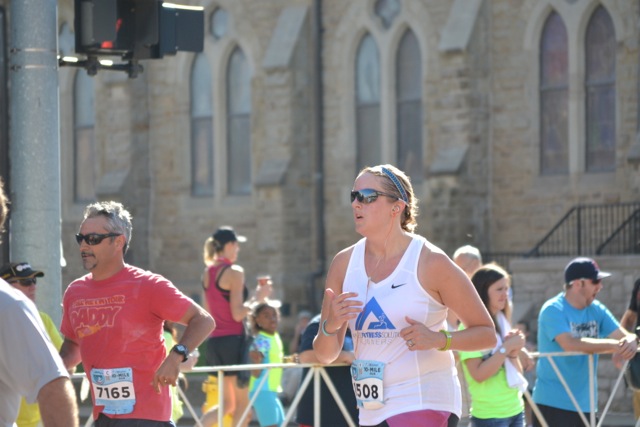Running is a great activity to burn calories and improve aerobic fitness. However, due to the high impact nature of running, a number of orthopedic issues can occur. One of the most common injuries is “Runner’s Knee.”
What Is Runner’s Knee
The commonly used term, “Runner’s Knee,” clinically refers to patellofemoral pain and is not only found in runners. Any sport that involves a high level of stress on the knee (such as sports that involve jumping, kicking, or higher impact) can result in patellofemoral pain. Its common occurrence in runners gives this condition its non-clinical name.
The primary symptom is a dull and achy pain on the front side of the knee, on or near the kneecap (or patella), or sometimes at the bottom portion of the patella as it connects to the tibia (the bigger lower leg bone). Pain can be made worse by activity, particularly higher impact activity like running or jumping, as well as activities like walking up and down stairs, deep squats, or sitting with the knee in a bent position for a long time.
How to Prevent Runner’s Knee
For any active person, preventing an injury proactively always is better than treating it reactively (when there’s actually a formal injury). Follow these four tips below to keep your knees safe and healthy when running:
- Lose Weight (if you need to): One of the easiest ways to prevent Runner’s Knee is to reduce stress on the knee by reducing the forces associated with impact. One of the best ways to do that is to lose weight, if you have some to lose. Some research suggests that for every 1 pound of weight you lose, you’ll take 3-6 pounds of stress off the knee joint. This clearly reduces the risk of injury, particularly if you lose over 10 pounds. With this said, clearly running should never be used as a form of exercise for weight loss.
- Progress Your Training Slowly: In general, progressing your running volume by 10 percent per week is appropriate. This means that if you start out with 9 miles per week (3 miles, 3 times per week,), the next week would be 9.9 miles, then 10.9, then 12 and so on. This ensures that your body acclimates to the loading being placed on the knee. This also means you should train first for a 5k, then a 10k, then a half marathon and beyond. Far too often new runners jump into training for a full marathon right off the bat and get injured in the process.
- Strength Train: One of the best ways to prevent injury is to make muscle and connective tissue stronger through strength training. Strength training to prevent Runner’s Knee should focus on good “posterior chain” strengthening. This means strengthening the glute, hamstring, and calf muscles. These muscles are associated with decelerating the leg during impact, which reduces the forces on the knee, thereby decreasing the risk of injury.
- Listen to Your Body: If you are starting to experience pain in the knee, it’s a sign something is wrong. Ignoring your symptoms and continue to train through the pain only makes things worse. If you notice any of the following, you likely have a problem that needs to be addressed (if any of these occur, you should seek the advice of a qualified health professional):
- Your pain is greater than 5 on a scale of 10,
- Your pain symptoms get worse(instead of resolve), as you run longer,
- Your knee noticeably swells after running, and/or
- Your knee pain is impairing activities of daily life.
Take Home Message
You can avoid Runner’s Knee if you are smart. For some people, mechanical factors (like improper knee tracking or flat feet) predispose them to this condition. However, for everyone else , the simple tips laid out in this article can greatly help to prevent the occurrence of Runner’s Knee and/or lessen the severity of it, if it occurs. Implement these tips today and start running pain-free!
If you’re looking for a fun group to run with check out AFS Runners!
About the Author:
-

Michael Stack is the founder & CEO of Applied Fitness Solutions and Frontline Fitness Pros. He is a faculty lecturer for the University of Michigan’s School of Kinesiology. He is also the creator and the host of the Wellness Paradox Podcast, produced in conjunction with University of Michigan.
Michael is an exercise physiologist by training and a health entrepreneur, health educator, and fitness industry advocate by trade. He is dedicated to enhancing the standard of practice of, and advocating for, fitness and wellness professionals to ensure they become an essential constituent in the healthcare delivery system.
With a career spanning over three decades in fitness, health, and wellness Michael has a deep knowledge of exercise physiology, health/wellness coaching, lifestyle interventions to mitigate chronic disease and leadership. He is credentialed through the American College of Sports Medicine (ACSM) as an Exercise Physiologist (ACSM-EP), Exercise is Medicine practitioner (ASCM-EIM), and a Physical Activity in Public Health Specialist (ACSM-PAPHS). Michael is a National Strength & Conditioning Association (NSCA) Certified Strength & Conditioning Specialist (CSCS), and a CDC Diabetes Prevention Program (DPP) Lifestyle Coach.
Michael received his undergraduate degree from the University of Michigan’s School of Kinesiology in 2004 and is currently a Master’s of Public Health (MPH) candidate at University of Michigan, with a specific concentration in health behavior and health education.
Michael is a board of directors’ member for the Physical Activity Alliance and Michigan Fitness Clubs Association. He sits on the University of Michigan’s School of Kinesiology Alumni Board of Governors. Michael is an expert curriculum reviewer for the American College of Lifestyle Medicine. Finally, he is a member of the executive leadership team for American Heart Association’s Heart Walk.
Michael lectures nationally for several health/fitness certification and continuing educations, including; IHRSA, the Medical Fitness Association, the National Strength & Conditioning Association, and SCW Fitness.

